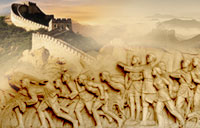Astronomers discover most Earth-like planet yet
Updated: 2015-07-24 07:31
(Agencies)
|
|||||||||||
Scientists previously have found Earth-sized planets orbiting in stars' so-called "habitable zones," but those stars are cooler and smaller than the sun, a G2 type yellow star.
NASA launched the Kepler telescope in 2009 to survey a sampling of nearby stars in an attempt to learn if planets like Earth were common in the galaxy.
"This is great progress in finding a planet like Earth that is similar in size and temperature around a sun-like star," said Kepler scientist Jeff Coughlin, with the SETI Institute in Mountain View, California.
Based on its size, scientists believe Kepler-452b should be rocky, like the Earth, though that theory is based on statistical analysis and computer modeling, not direct evidence.
"With a radius 60 percent larger than the Earth, this planet has a somewhat better than even chance of being rocky," Jenkins said.
If so, Kepler-452b could be about five times as massive as Earth and have gravity that is twice as strong as what exists on Earth's surface. The planet also could have a thick atmosphere, cloudy skies and active volcanoes, Jenkins said.
With the discovery of Kepler-452b, the telescope has found 1,030 confirmed planets and identified about 4,700 candidate planets. The list of potential planets includes 11 other near-Earth twins, nine of which circle sun-like stars.
The telescope cannot see planets directly, but measures minute changes in light coming from target stars. Sophisticated computer programs and follow-up observations with a ground-based telescopes then determine if some of the light dips were caused by planets passing in front of their parent stars, relative to Kepler's line of sight.
A positioning system failure ended the telescope's prime planet-hunting mission in 2013, but it has since been repurposed for other astronomical observations.
Attempts to learn if Kepler-452b has an atmosphere likely will have to wait for a new generation of more sensitive space telescopes, said NASA's associate administrator John Grunsfeld.
The research will be published in The Astronomical Journal.
Related Stories
Alone on a Lonely Planet 2015-04-30 07:22
Your city in the shape of tiny round planet 2015-03-26 11:05
Explore the planet's most southern point 2015-03-18 07:18
Russian Soyuz lifts new crew to space station 2015-07-23 09:13
Beijing and Shanghai surpass major US cities in green space rollout 2015-07-09 17:25
Today's Top News
Japan's Nikkei buys Financial Times in $1.3 bln deal
Greek parliament passes crucial bailout bill
Ministry: No date set for nationwide two-child policy
'Spartans' detained by Beijing police for disturbing order
Shanghai says no futures trading manipulation in FTZ
More Chinese companies become world top 500
Another month, another global heat record broken
Forbidden City enters Secret Garden for different shade
Hot Topics
Lunar probe , China growth forecasts, Emission rules get tougher, China seen through 'colored lens', International board,
Editor's Picks

|

|

|

|

|

|






